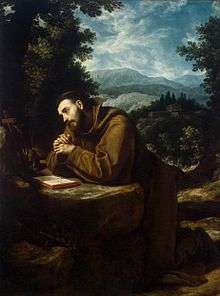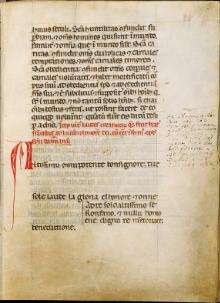Canticle of the Sun
The Canticle of the Sun, also known as Laudes Creaturarum (Praise of the Creatures) and Canticle of the Creatures, is a religious song composed by Saint Francis of Assisi. It was written in an Umbrian dialect of Italian but has since been translated into many languages. It is believed to be among the first works of literature, if not the first, written in the Italian language.[1]

The Canticle of the Sun in its praise of God thanks Him for such creations as "Brother Fire" and "Sister Water". It is an affirmation of Francis' personal theology as he often referred to animals as brothers and sisters to Mankind, rejected material accumulation and sensual comforts in favor of "Lady Poverty".
Saint Francis is said to have composed most of the canticle in late 1224 while recovering from an illness at San Damiano, in a small cottage that had been built for him by Saint Clare and other women of her Order of Poor Ladies. According to tradition, the first time it was sung in its entirety was by Francis and Brothers Angelo and Leo, two of his original companions, on Francis' deathbed, the final verse praising "Sister Death" having been added only a few minutes before.
A legend which emphasizes the topos of "brightness" says he did not physically write the Canticle, because of his blindness from an eye disease; but he dictated it and he did it looking at Nature through the eye of mind. Father Eric Doyle wrote: "Though physically blind, he was able to see more clearly than ever with the inner eye of his mind. With unparalleled clarity he perceived the basic unity of all creation and his own place as a friar in the midst of God’s creatures. His unqualified love of all creatures, great and small, had grown into unity in his own heart. He was so open to reality that it found a place to be at home in his heart and he was at home everywhere and anywhere. He was a centre of communion with all creatures".[2]
The Canticle of the Sun is first mentioned in the Vita Prima of Thomas of Celano in 1228.
Text and translation
|
Original text in Umbrian dialect: Altissimu, omnipotente bon Signore, Ad Te solo, Altissimo, se konfano, Laudato sie, mi Signore cum tucte le Tue creature, Laudato si, mi Signore, per sora Luna e le stelle: Laudato si, mi Signore, per frate Uento Laudato si, mi Signore, per sor'Acqua, Laudato si, mi Signore, per frate Focu, Laudato si, mi Signore, per sora nostra matre Terra, Laudato si, mi Signore, per quelli ke perdonano per lo Tuo amore Beati quelli ke 'l sosterranno in pace, Laudato si mi Signore, per sora nostra Morte corporale, Laudate et benedicete mi Signore et rengratiate Notes: so=sono, si=sii (be!), mi=mio, ka=perché, u and v are both written as u, sirano=saranno
|
English Translation: Most High, all powerful, good Lord, To You alone, Most High, do they belong, Be praised, my Lord, through all your creatures, Praised be You, my Lord, through Sister Moon and the stars, Praised be You, my Lord, through Brother Wind, Praised be You, my Lord, through Sister Water, Praised be You, my Lord, through Brother Fire, Praised be You, my Lord, through Sister Mother Earth, Praised be You, my Lord, Blessed are those who endure in peace Praised be You, my Lord, Woe to those who die in mortal sin. Praise and bless my Lord, |
Alternative versions

Perhaps the best-known version in English is the hymn "All Creatures of Our God and King", which contains a paraphrase of Saint Francis' song by William H. Draper (1855–1933). Draper set the words to the 17th-century German hymn tune "Lasst uns erfreuen", for use at a children's choir festival sometime between 1899 and 1919.[4]
Franz Liszt (1811–1886) composed several pieces titled "Cantico del sol di Francesco d'Assisi", with versions for solo piano, organ, and orchestra, composed or arranged between 1862 and 1882.
Hermann Suter composed an oratorio Le Laudi on the Italian words, premiered in 1924.
The American composer Amy Beach (1867–1944) set the Canticle to music for organ or orchestra, choir, and solo vocal quartet, in 1924. The piece was first performed with organ in 1928 at St. Bartholomew's in New York. The orchestral version was first performed by the Chicago Symphony and the Toledo Choral Society in 1930.
Nobilissima Visione (1938), a ballet by Paul Hindemith about Francis, references the Canticle in the final section.
Leo Sowerby (1895–1968) set Matthew Arnold's English translation of the Canticle for chorus and orchestra in 1945 (The Canticle of the Sun); the work was awarded the Pulitzer Prize for Music the following year.
Charles Martin Loeffler (1861–1935) set a modern Italian translation of the original Umbrian dialect text for soloists and chamber orchestra ca. 1929 which was performed in the same 1945 Carnegie Hall concert as Sowerby's setting.
Laudes Creaturarum was also been set to music, in 1954, by German composer Carl Orff.
American poet Robert Lax titled his 1959 poem "The Circus of the Sun" in tribute to The Canticle.[5]
Roy Harris (1898–1979) composed a setting for soloists and a large ensemble in 1961.
In the 1961 film, Francis of Assisi, the actor playing Brother Leo begins to sing the canticle but is overwhelmed by tears. Francis (Bradford Dillman) continues proclaiming, not singing, the rest.
Seth Bingham (1882–1972) made a setting in 1962.
San Francisco organist-composer Richard Purvis, who presided at Grace Cathedral, wrote a St. Francis Suite in 1964 [6] which featured Canticle of the Sun as its concluding movement.
A modern rendition, composed by pop singer/composer Donovan, was used in the 1972 musical biography of Saint Francis, Brother Sun, Sister Moon.
Another setting of the Canticle of the Sun, titled Cantico del sole was composed by William Walton (1902–1983) in 1974 for the Cork International Choral Festival.
American composer Marty Haugen wrote a setting in 1980, published by GIA Publications entitled "Canticle of the Sun."
The acclaimed Spanish composer Joaquín Rodrigo composed a piece to the words in Spanish of the Canticle, for choir and orchestra in 1982: Cantico de San Francisco de Asis.
Russian composer Sofia Gubaidulina wrote a piece dedicated to cellist Mstislav Rostropovich in 1997 for his 70th birthday.
The Italian folk singer Angelo Branduardi composed a ballad entitled "Il cantico delle creature" in year 2000 based on the original lyrics of the Canticle.
The lines "Brother Sun" and "Sister Moon" inspired the 2006 album Brother, Sister by indie rock band mewithoutYou.
The song "Brother Moon" by Gungor on their 2011 album Ghosts Upon the Earth was inspired by the Canticle.
Estonian composer Tõnu Kõrvits (b. 1969) composed a 12-part A cappella piece for mixed choir (SSAATTBB) "The Canticle of the Sun" for Southern Chorale choir in 2014.
Italian pop singer Jovanotti performed the song as part of a special concert in Assisi in 2014. It was simply him and another guitarist performing "unplugged" style.
Pope Francis published his second encyclical Laudato si' on June 18, 2015. The Canticle inspired the encyclical's title, "Praise be to you," and was quoted in the first paragraph, "Praise be to you, Our Lord, through our Sister, Mother Earth, who sustains and governs us, and who produces various fruits, with colored flowers and herbs."
The Irish composer Vincent Kennedy was commissioned by the Irish Franciscans to set the Canticle of the Sun for Soprano, Harp and Trumpet. The resulting work has 9 songs containing the complete text of the Canticle. The first performance took place in the Franciscan church of Adam and Eve in Dublin on 4 June 2017.
References
- "Franciscan Friars Third Order Regular - Canticle of Brother Sun". Archived from the original on 22 November 2010. Retrieved 7 October 2010.
- Doyle, Eric (1996). St. Francis and the Song of Brotherhood and Sisterhood. Franciscan Institute. ISBN 978-1576590034.
- Translation by the Franciscan Friars Third Order Regular Archived 2010-11-22 at the Wayback Machine, accessed 5 October 2016.
- "All Creatures of Our God and King". Hymnary.org.
- Levertov, Denis (October 14, 1961). "Poets of the Given Ground". The Nation: 251–253.
- {{cite web |url=http://www.bu.edu/phpbin/organ-library/details.php?id=46117%7Ctitle=American Guild of Organists Web Catalog
